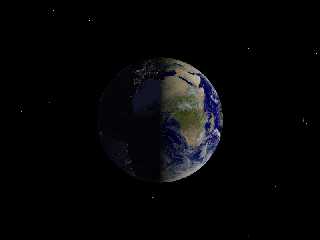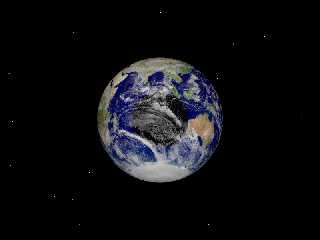|
 |
Hi(gh)!
Meanwhile, I almost got the boundary between day and night Earth texture
right (by rotating the gradient of the texture_map using vrotate) - but
still a portion of the night texture shows up on the opposite side of
the night hemisphere (see second attached image below).
Here is my code for the time being:
#declare sc=1; // scaling factor, should be 13347, i. e. 1 POV unit
equals 13,347 kilometres
#declare T_Earth_Night =
texture
{
pigment
{
image_map
{
png "solarsys/ev5826_land_ocean_ice_lights_8192.png"
map_type 1
interpolate 2
}
}
finish
{
ambient 0.5
diffuse 0
}
}
#declare T_Earth_Day =
texture
{
pigment
{
image_map
{
png "solarsys/ev11612_land_ocean_ice_8192_POV.png"
map_type 1
interpolate 2
}
}
finish { F_Standard_Planetary_Surface }
}
#macro SetAxis(dec, ras) // declination, right ascension (in degrees!)
of planet's celestial north pole relative to Earth's celestial north pole
rotate <bodies[3][4]-(90-dec), 0, 0>
rotate <0, 90-ras, 0>
#end
union
{
sphere // Earth, surface
{
0, 1
texture
{
#declare grd=vrotate(z, -<bodies[3][4], 0, 0>);
gradient vrotate(grd, <0, orb_ang, 0>)
texture_map
{
[0.45 T_Earth_Day translate z*1 scale 0.5]
[0.45 T_Earth_Night translate z*1 scale 0.5]
}
scale 2
translate <0, 0, -1>
}
scale <bodies[3][1], bodies[3][3], bodies[3][2]>/sc
}
sphere // Earth, clouds
{
0, 1
texture
{
pigment
{
image_map
{
png "solarsys/cloud_combined_8192a_alpha.png"
map_type 1
interpolate 2
}
}
finish { F_Standard_Planetary_Surface }
}
scale <bodies[3][1]+5, bodies[3][3]+4.983270985, bodies[3][2]+5>/sc
}
rotate -y*clock
SetAxis(bodies[3][10], bodies[3][11]) // 90, 90
translate Pos_Earth/sc
}
// end of code
Earth's position on its orbit (for the time being I use circular orbits)
How do I get rid of the repetition of the gradient pattern?
See you in Khyberspace!
Yadgar
Post a reply to this message
Attachments:
Download '2012-05-19 earth, take 78 - view from 45,000 kms.png' (124 KB)
Download '2012-05-19 earth, take 80 - view from 45,000 kms.png- view from 45,000 kms.png' (173 KB)
Preview of image '2012-05-19 earth, take 78 - view from 45,000 kms.png'

Preview of image '2012-05-19 earth, take 80 - view from 45,000 kms.png- view from 45,000 kms.png'

|
 |




![]()